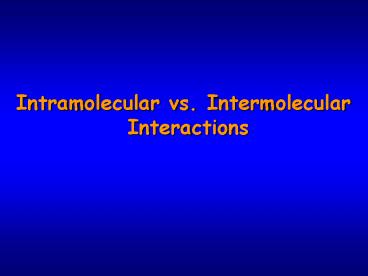Intramolecular vs' Intermolecular - PowerPoint PPT Presentation
1 / 17
Title:
Intramolecular vs' Intermolecular
Description:
C=O bond 165 kcal/mol 1.21 . Compared to most non-covalent ... Example: Acetone pointing directly at Na ion (q = zero) at a distance of 1 nm (in chloroform) ... – PowerPoint PPT presentation
Number of Views:449
Avg rating:3.0/5.0
Title: Intramolecular vs' Intermolecular
1
Intramolecular vs. Intermolecular Interactions
2
Covalent Bond Energies
C-O bond 81 kcal/mol 1.43 Å C-C bond 86
kcal/mol 1.54 Å C-H bond 103 kcal/mol 1.11 Å CC
bond 143 kcal/mol 1.33 Å CO bond 165
kcal/mol 1.21 Å
Compared to most non-covalent interactions these
are Very high energies Very short
distances Highly dependant on orientation
3
Covalent bonding
- Sharing of electrons to achieve a stable electron
configuration - Small difference in electronegativity of
elements - Bond energy 50-100 kcal/mol
- Directional bond between specific atoms in a
specific direction, normally along the line
connecting the two atoms that share a pair of
electrons.
4
Atomic Orbitals of Carbon
5
d-orbitals
6
(No Transcript)
7
sp3 hybridization of carbon orbitals
8
sp2 hybridization of carbon orbitals
9
sp hybridization of carbon orbitals
10
Intermolecular Interactions Driving Forces for
the Formation of Supramolecular Structures
- ? hydrophobic interaction lt10 kcal/mol
- ? electrostatic interaction 5 kcal/mol
- ? hydrogen bond interaction 2-10 kcal/mol
- ? p-p aromatic interaction 0-10 kcal/mol
- ? van der Waals interaction 0.1-1 kcal/mol
- The total intermolecular force acting between two
molecules is the sum of all the forces they exert
on each other.
11
A. IonIon Interaction
-
Can be a very strong bond - even stronger then
covalent bonds in some cases. Can be an
attractive or a repulsive force. Non-directional
force Long range (1/r) Highly dependant on the
dielectric constant of the medium
12
A. IonIon Interaction
Energy (k . z1 . z2 . e2) / (??.?r12)
k 1 / 4p?o Coulomb constant 9 .109 N.m2/C2
e elementary charge 1.6 .10-19C
? dielectric constant
r12 distance between the charges
The energy of an ion-ion interaction only
decreases at a rate proportional to 1 / r.
Therefore these are very long range forces.
13
A. IonIon Interaction
When designing a host / guest complex, what will
be the energetic incentive for bringing two
oppositely charged species to a distance of 3 nm
of one another in water?
Energy (k . z1 . z2 . e2) / (??.?r12) 9 .109
. 1 . (-1) . (1.6 .10-19)2 / 78.5 . 3 . 10-9
-2.3 . 10 -28 / 2.4 . 10 -7 -9.8 . 10-22 J
-0.14 kcal/mol
14
A. IonIon Interaction
1 nm in water?
Energy (k . z1 . z2 . e2) / (??.?r12) 9 .109
. 1 . (-1) . (1.6 .10-19)2 / 78.5 . 1 . 10-9
-2.3 . 10-28 / 0.8 . 10 -7 -29.4 . 10-22 J
-0.42 kcal/mol
1 nm in Chloroform?
9 .109 . 1 . (-1) . (1.6 .10-19)2 / 4.8 . 1 .
10-9 -2.3 . 10-28 / 4.8 . 10-9 -4.79 . 10-20
J -6.89 kcal/mol ? 8 of a C-C bond
15
B. Ion-Dipole Interaction
Weakly directional forces Can be attractive or
repulsive Medium range interactions
(1/r2) Significantly weaker then ion-ion
interactions
16
B. Ion-Dipole Interaction
Energy -(k . Q . u . cosq / e . r2) Maximum
when q 0 or 180 degrees Zero when q 90
degrees u q . l u dipole moment l length
of the dipole q partial charge on dipole r
distance from charge to center of dipole Q
charge on ion
17
B. Ion-Dipole Interaction
Example Acetone pointing directly at Na ion (q
zero) at a distance of 1 nm (in chloroform)
Energy -(k . Q . u . cosq / e . r2) If q
zero -k . Q . u / e . r2 -9 .109 . 1.6 .10-19
. 2.9 . 3.336 .10-30 / e . r2 -1.39 . 10-38 /
4.8 . (10-9)2 -2.9 . 10-21 J -0.42 kcal/mol






























